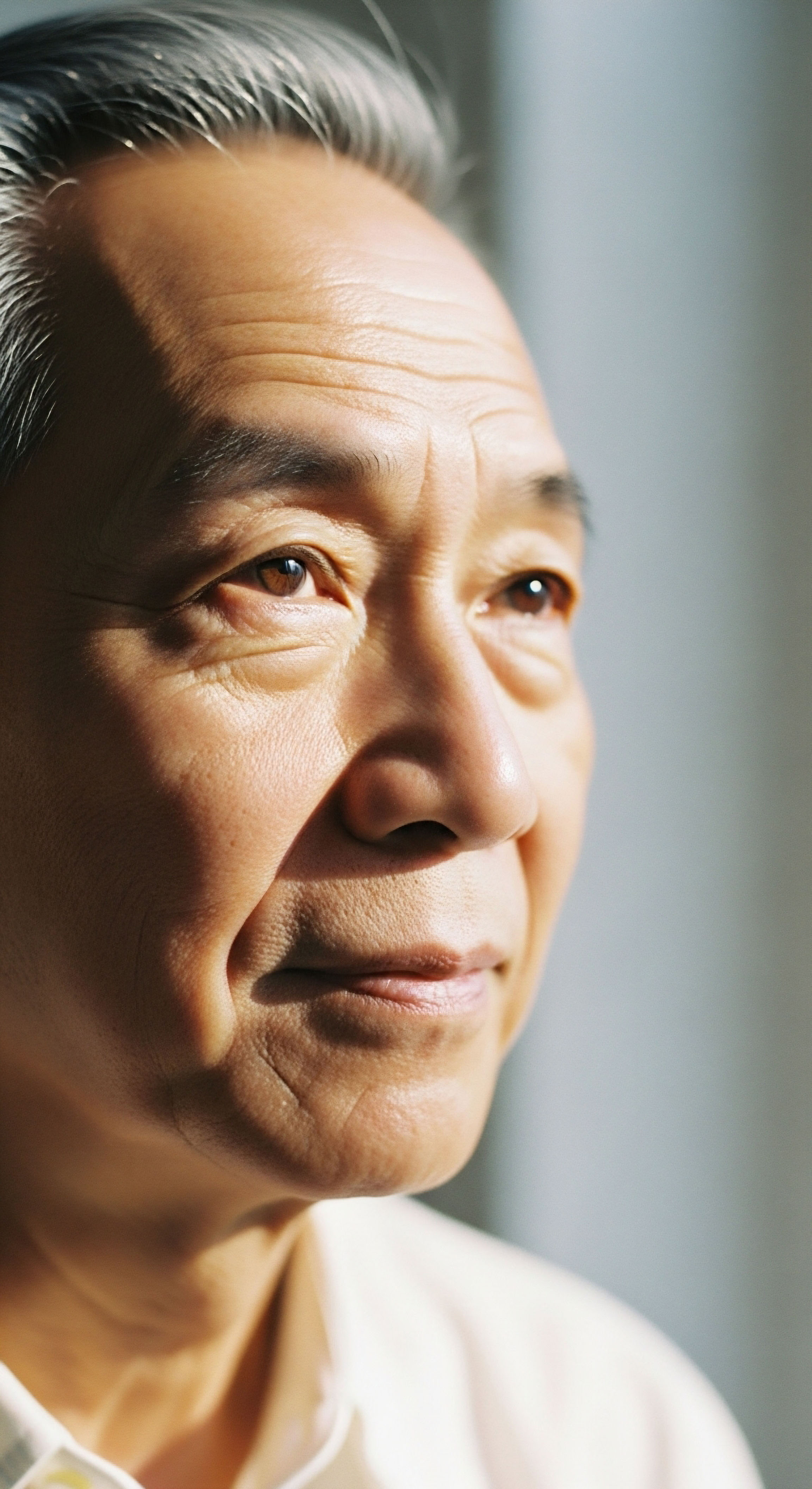

Fundamentals
You feel a change in your body’s internal landscape. A subtle shift in energy, a difference in recovery after exercise, or a new pattern in your mood may have initiated your search for answers. This investigation into your own biology is a foundational step toward reclaiming a sense of vitality.
When you ask, “Can men take estrogen for wellness purposes?”, you are truly asking how your body’s intricate communication network functions and how you can support it. The answer resides in understanding the sophisticated balance of your own endocrine system. Men’s wellness protocols focus on optimizing the body’s endogenous production and regulation of estrogen, which is synthesized from testosterone. The goal is to achieve a state of hormonal equilibrium that is specific to your own physiology.
Your body is governed by a complex and elegant system of chemical messengers. These hormones are produced in glands and travel throughout your bloodstream, carrying instructions that regulate everything from your metabolism to your mood. Among these messengers, estrogens, particularly the form known as estradiol (E2), perform essential functions in the male body.
While testosterone is the principal male androgen, estradiol is also present and necessary for complete health. Its presence is a result of a natural and continuous biological process. A specific enzyme called aromatase, found in various tissues including body fat, the brain, and the testes, converts a portion of testosterone into estradiol. This conversion is a fundamental aspect of male physiology, ensuring that your body has the necessary components for a wide range of functions.
Estradiol is a vital hormone in male physiology, produced from testosterone and essential for bone, brain, and cardiovascular health.

The Essential Functions of Estradiol in Male Health
The concept of estrogen in men often requires a shift in perspective. Its role is specific and supportive, contributing to the overall architecture of male health in several key domains. A deficiency or an excess of this hormone can disrupt these systems, leading to tangible symptoms that affect daily life. Understanding these functions provides a clear picture of why balance, rather than simple addition or subtraction, is the objective of any wellness protocol.

Bone and Skeletal Integrity
One of the most well-documented roles of estradiol in men is the maintenance of bone density. The hormone is a critical signal for regulating the process of bone turnover, the constant cycle of breaking down old bone and forming new bone. Estradiol helps to slow the rate of bone resorption, protecting skeletal structure throughout life.
The importance of this function is clearly demonstrated in rare cases of men with genetic conditions that prevent them from producing or responding to estrogen. These individuals often experience significant reductions in bone mineral density and are prone to fractures, even with normal or high testosterone levels. This illustrates that testosterone and estradiol work together to maintain a strong skeleton.

Cardiovascular System Support
Estradiol also contributes to the health of the cardiovascular system. It has a positive influence on cholesterol metabolism, helping to maintain a healthier lipid profile. Furthermore, it supports the function of the endothelium, the inner lining of your blood vessels, which is vital for regulating blood pressure and blood flow.
The presence of estrogen receptors on cardiovascular tissues underscores the hormone’s direct role in this system. Maintaining an appropriate level of estradiol is part of the complex web of factors that support long-term heart health.

Regulation of Brain Function and Libido
The brain is another primary site of estrogen activity in men. Aromatase is highly active in the brain, where locally produced estradiol influences numerous neurological functions. It plays a part in modulating mood, cognitive processes, and, importantly, libido. Both testosterone and estradiol are involved in regulating sexual desire.
An imbalance, with either too little or too much estradiol relative to testosterone, can dampen libido and affect sexual function. This highlights the delicate interplay between these two steroid hormones in the central nervous system.

Estrogen Receptors the Gateway to Action
For estradiol to exert its effects, it must first bind to specific proteins called estrogen receptors (ER). Think of these receptors as locks and estradiol as the key. When the key enters the lock, it initiates a series of events inside the cell, leading to a specific biological response.
Men have two main types of estrogen receptors, Estrogen Receptor Alpha (ERα) and Estrogen Receptor Beta (ERβ), which are found in tissues throughout the body. The distribution and concentration of these receptors vary from one tissue to another, which allows estradiol to have different effects in different parts of the body.
For example, the receptors in bone tissue respond to estradiol by signaling for the preservation of bone mass, while receptors in the brain are involved in regulating mood and libido. The existence of this intricate receptor system is definitive proof that estrogen is an integral part of male biology.


Intermediate
Your understanding of health has moved beyond simple fixes. You recognize that your body operates as a system of systems, where balance is the key to optimal function. This brings us to a more sophisticated concept in hormonal health the Testosterone to Estradiol (T/E2) ratio.
This ratio is a more meaningful indicator of your endocrine status than looking at either hormone in isolation. Think of it as an internal thermostat that your body is constantly adjusting. When this ratio is within its optimal range for your physiology, systems from your metabolism to your cognitive function operate efficiently.
Clinical protocols for hormonal optimization, such as Testosterone Replacement Therapy (TRT), are designed with this principle in mind. The objective is to restore not just testosterone levels, but the functional equilibrium between testosterone and its essential metabolite, estradiol.

What Is the Optimal Hormonal Balance in Men?
Defining a single “optimal” T/E2 ratio is challenging because individual physiology varies. However, clinical data points to a range where most men function best. Healthy adult men typically have total testosterone levels between 300-1000 ng/dL and estradiol levels between 10-40 pg/mL.
The ratio itself is a calculated value that helps a clinician assess the activity of the aromatase enzyme. A significant deviation in this ratio, in either direction, signals an imbalance that can manifest in a variety of symptoms. Monitoring this ratio is a standard part of a comprehensive approach to managing male hormonal health, especially for individuals undergoing TRT.

The Consequences of Insufficient Estradiol
A state of low estradiol, often because of low testosterone or the overuse of medications that block aromatase, creates a distinct set of physiological problems. The human models of congenital aromatase deficiency, where the body cannot produce estrogen, provide a stark illustration of its necessity.
Men with this condition, despite having normal or even high levels of testosterone, exhibit a specific cluster of symptoms. They often have low bone mineral density, leading to osteoporosis and an increased risk of fractures. They also tend to accumulate visceral fat, the metabolically active fat around the organs, and show signs of insulin resistance, which increases the risk for metabolic syndrome and diabetes. These cases provide definitive evidence that testosterone alone is insufficient for maintaining skeletal and metabolic health.
The balance between testosterone and estradiol is a more accurate indicator of male hormonal health than either hormone considered alone.

The Consequences of Excess Estradiol
Conversely, an elevated level of estradiol relative to testosterone also disrupts physiological function. This scenario is more commonly encountered in clinical practice, particularly among men on TRT where a portion of the administered testosterone converts to estradiol. It can also occur in men with increased adipose tissue, as fat cells are a primary site of aromatase activity. The symptoms of high estradiol are distinct and can significantly impact quality of life. These include:
- Gynecomastia ∞ The development of male breast tissue, which can range from minor tenderness to noticeable growth.
- Water Retention and Bloating ∞ Estradiol can influence how the body handles sodium and water, leading to a feeling of puffiness or edema.
- Mood Swings and Emotional Lability ∞ An excess of estradiol can affect neurotransmitter systems in the brain, sometimes resulting in heightened emotional sensitivity or irritability.
- Reduced Libido and Erectile Dysfunction ∞ While low estradiol can impair sexual function, high levels can also suppress libido and interfere with the mechanics of an erection.
The following table outlines the contrasting symptoms associated with estradiol imbalance, providing a clearer picture of why maintaining equilibrium is so important.
| Symptom Category | Low Estradiol Symptoms | High Estradiol Symptoms |
|---|---|---|
| Skeletal Health | Low bone mineral density, joint aches, increased fracture risk. | Generally no direct negative skeletal symptoms, but associated with other systemic issues. |
| Body Composition | Increased visceral (internal) fat, difficulty building muscle. | Increased subcutaneous (under the skin) fat, water retention, potential for gynecomastia. |
| Metabolic Health | Insulin resistance, poor lipid profiles. | Can be associated with metabolic disruption, often linked to the underlying cause (e.g. obesity). |
| Sexual Function | Low libido, erectile dysfunction, diminished orgasmic intensity. | Low libido, erectile dysfunction, difficulty achieving orgasm. |
| Mood & Cognition | Anxiety, depressive symptoms, brain fog. | Mood swings, irritability, emotional over-reactivity. |

Clinical Management during Testosterone Replacement Therapy
For men diagnosed with clinical hypogonadism (low testosterone with corresponding symptoms), TRT is a standard and effective treatment. A primary goal during TRT is to maintain a healthy T/E2 ratio. As supplemental testosterone is introduced, the activity of the aromatase enzyme can lead to a rise in estradiol levels.
If this rise is excessive and causes symptoms, a clinician may introduce an aromatase inhibitor (AI), such as Anastrozole. Anastrozole works by blocking the aromatase enzyme, thereby reducing the conversion of testosterone to estradiol. The use of an AI is a nuanced part of therapy.
The objective is to guide estradiol levels back into the optimal range, not to eliminate the hormone entirely. Over-suppression of estradiol with an AI would lead to the symptoms of estrogen deficiency. This is why regular blood work and symptom monitoring are integral parts of a properly managed TRT protocol. It allows for precise, personalized adjustments to maintain the delicate hormonal balance required for overall wellness.


Academic
A sophisticated examination of estrogen’s role in male physiology moves beyond systemic balance and into the molecular realm of receptor-mediated signaling. The biological effects of estradiol are dictated by its interaction with two distinct nuclear receptors ∞ Estrogen Receptor Alpha (ERα) and Estrogen Receptor Beta (ERβ).
These two receptors are products of different genes (ESR1 and ESR2, respectively) and, while they both bind estradiol, they exhibit different tissue distributions and can initiate different, sometimes opposing, transcriptional programs within the cell. This duality is the source of much of the complexity and elegance of estrogen signaling in men.
Understanding the specific functions of ERα and ERβ is essential for appreciating how estradiol can be both protective in some tissues, like the prostate and brain, while being proliferative in others. This receptor-specific perspective provides the framework for understanding disease pathology and for developing future therapeutic strategies.

The Tale of Two Receptors ERα and ERβ
The discovery of a second estrogen receptor, ERβ, in the mid-1990s fundamentally changed our understanding of estrogen action. It became clear that the physiological response of a given tissue to estradiol depends on the relative expression levels of ERα and ERβ within its cells.
These receptors can form homodimers (αα or ββ) or heterodimers (αβ) on estrogen response elements in the DNA, each combination potentially regulating a unique set of target genes. This combinatorial complexity allows for an incredibly fine-tuned and tissue-specific response to a single hormone.

ERα the Primary Mediator of Classical Estrogenic Effects
Estrogen Receptor Alpha is largely responsible for what are considered the classical estrogenic actions in both sexes. In men, ERα signaling is dominant in several key systems. Studies using knockout mouse models, where the gene for ERα is deleted, have been instrumental in elucidating its function.
Male mice lacking ERα are infertile, primarily because of disruptions in the efferent ductules of the testes, which are responsible for reabsorbing fluid and concentrating sperm. This leads to sperm that are dysfunctional. Furthermore, these mice exhibit skeletal deficits, with unfused epiphyses and reduced bone density, mirroring the symptoms seen in aromatase-deficient men.
This confirms that ERα is the primary mediator of estrogen’s essential role in skeletal maturation and maintenance. ERα is also the key receptor involved in the negative feedback loop of the Hypothalamic-Pituitary-Gonadal (HPG) axis, where estradiol signals the brain to reduce the production of luteinizing hormone (LH), thereby controlling testosterone synthesis in the testes.

ERβ the Modulator and Protector
Estrogen Receptor Beta often plays a modulatory or opposing role to ERα. Its expression is prominent in tissues like the prostate epithelium, certain areas of the brain, the colon, and the immune system. In the prostate, ERβ signaling is generally considered to be anti-proliferative.
It appears to counterbalance the growth-promoting signals that can contribute to conditions like benign prostatic hyperplasia (BPH). This suggests that a healthy balance of ERα and ERβ activity is critical for maintaining prostate health. In the central nervous system, ERβ is implicated in neuroprotective functions, potentially shielding neurons from oxidative stress and injury.
Its role in mood regulation and anxiety is also an active area of research. The distinct, often protective, functions of ERβ highlight the sophistication of estrogen signaling. The overall effect of estradiol in a tissue is a result of the integrated output of both receptor subtypes.
The distinct functions of Estrogen Receptor Alpha and Estrogen Receptor Beta allow estradiol to perform varied and tissue-specific roles throughout the male body.

How Does Receptor Distribution Influence Male Health?
The specific location and concentration of ERα and ERβ determine how different organ systems respond to circulating estradiol. This differential expression is the key to understanding how estrogen can be beneficial in one context and potentially problematic in another. The following table provides a simplified overview of this distribution and the primary functions associated with each receptor in key male tissues.
| Tissue/System | Primary Receptor | Associated Primary Function |
|---|---|---|
| Bone | ERα | Mediates epiphyseal (growth plate) closure and maintains bone mineral density. |
| Testes (Efferent Ductules) | ERα | Regulates fluid reabsorption, essential for sperm concentration and fertility. |
| Brain (Hypothalamus) | ERα | Mediates negative feedback on LH and testosterone production. |
| Brain (Various Regions) | ERα & ERβ | Jointly regulate libido, mood, and cognitive functions. ERβ may have specific neuroprotective roles. |
| Prostate Gland | ERβ (in epithelium), ERα (in stroma) | ERβ signaling is thought to be anti-proliferative, while ERα may mediate stromal growth. Balance is key. |
| Adipose Tissue (Fat) | ERα & ERβ | Regulates fat storage, distribution, and inflammation. Imbalances are linked to metabolic syndrome. |
| Cardiovascular System | ERα & ERβ | Both receptors are present in blood vessels and heart tissue, contributing to vascular health and lipid metabolism. |

Implications for Systemic Health and Disease
This receptor-specific understanding has profound implications for male health over the lifespan. For instance, the age-related decline in testosterone leads to a subsequent decline in estradiol. This reduction in ligand for both ERα and ERβ contributes to the development of osteoporosis, metabolic changes, and shifts in cognitive function.
In the context of prostate health, an imbalance in the ratio of testosterone to estrogen, or a shift in the relative activity of ERα versus ERβ, is hypothesized to be a factor in the development of BPH and potentially other prostate pathologies.
The goal of a sophisticated wellness strategy, therefore, is to support an endocrine environment that promotes healthy signaling through these receptor pathways. This involves managing the T/E2 ratio through diet, exercise, and, when clinically indicated, medical therapies that are precisely monitored to maintain this intricate balance. The idea of simply taking estrogen for wellness is revealed to be a simplistic approach to a highly complex and elegant biological system.

References
- Cooke, Paul S. and Rex A. Hess. “Estrogens in Male Physiology.” Physiological Reviews, vol. 97, no. 3, 2017, pp. 995-1043.
- Schulster, Michael, et al. “The Role of Estradiol in Male Reproductive Function.” Asian Journal of Andrology, vol. 18, no. 3, 2016, pp. 435-440.
- Carani, C. et al. “Diagnosis and treatment of estrogen deficiency in men.” Endocrine Abstracts, vol. 20, 2009, P25.
- Vandenput, Liesbeth, and Claes Ohlsson. “Estrogens as regulators of bone health in men.” Nature Reviews Endocrinology, vol. 5, no. 8, 2009, pp. 437-443.
- Bhasin, Shalender, et al. “Testosterone Therapy in Men With Hypogonadism ∞ An Endocrine Society Clinical Practice Guideline.” The Journal of Clinical Endocrinology & Metabolism, vol. 103, no. 5, 2018, pp. 1715-1744.
- Hamilton, K.J. and E.S.P. Hewitt. “Estrogen receptors alpha (ERα) and beta (ERβ) ∞ Subtype-selective ligands and clinical potential.” Journal of Medicinal Chemistry, vol. 57, no. 15, 2014, pp. 6225-6240.
- Bulun, Serdar E. “Aromatase Deficiency in Women and Men.” Molecular and Cellular Endocrinology, vol. 178, no. 1-2, 2001, pp. 121-125.
- Yeap, Bu B. et al. “Testosterone, estradiol and their ratio in male patients with acute coronary syndrome.” Hormone Molecular Biology and Clinical Investigation, vol. 45, no. 2, 2024, pp. 123-129.
- Finkelstein, Joel S. et al. “Gonadal Steroids and Body Composition, Strength, and Sexual Function in Men.” New England Journal of Medicine, vol. 369, no. 11, 2013, pp. 1011-1022.
- Glaser, Rebecca L. and Constantine Dimitrakakis. “Testosterone and the Breast ∞ The Role of Aromatase.” Maturitas, vol. 76, no. 3, 2013, pp. 225-230.

Reflection

Calibrating Your Internal Orchestra
You have now explored the intricate science of your body’s hormonal communication network. You see that your internal environment is a dynamic system, a conversation between powerful molecules and intelligent receptors. The information presented here is a map, showing the territories and pathways of your own physiology. This knowledge is the first and most powerful tool in your possession. It allows you to ask more precise questions and to become an active participant in your own health narrative.
Consider the symptoms or goals that began your inquiry. How does this deeper understanding of hormonal balance reframe your perspective? The path to sustained vitality is one of continuous learning and precise calibration. Your unique biology requires a personalized approach, guided by data and an understanding of the interconnectedness of your internal systems. This journey is about tuning your own biological orchestra to create a symphony of optimal function. What is the next note you want to play?



